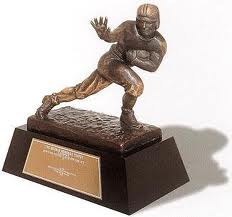John William Heisman was born, fittingly, in 1869, the same year the first intercollegiate football game was contested between Princeton and Rutgers.
- Heisman played in his first football game at age 17 for Titusville High School in western PA. He did so against the wishes of his father, who described the game as "bestial."
- He starred as a 5'10" 155 lb lineman at Brown from 1887-1890.
- John transferred to Pennsylvania to study law, taking the opportunity to play another two seasons of varsity ball.
In 1892, he quit law school to coach football at Oberlin College in Ohio. Thus began a 36-year coaching career at eight different colleges.
- "Heisman ... usually wore a high turtleneck sweater and a baseball cap when he walked the sidelines (and never showing anything that might possibly be construed as a smile)."
- His Oberlin team won all seven games that first year.
- John then moved to Akron for the '93 season but returned to Oberlin in '94.
Heisman introduced many innovations to the fledgling game.
- He experimented with hidden ball tricks.
- He instituted a shouted signal ("Hike" or "Hep") to trigger the center snap.
- He developed a double-lateral pass that spread to other teams.
- John advocated dividing the game into quarters.
- He campaigned for three years to legalize the forward pass, a goal he achieved in 1906 after the national furor over excessive violence in the game attracted the attention of President Theodore Roosevelt.
Heisman continued his peripatetic career at Auburn from 1895-99.
- After compiling a 12-4-2 record on The Plains, he moved to another Southern Intercollegiate Conference school, Clemson. The Tigers went 19-3-2 during his four years there.
- John then took the job at the school he is most often associated with because he spent his longest stint there, 16 years - Georgia Tech.
Heisman's most famous game occurred in Atlanta.
- In 1916, Tech scheduled a game against tiny Cumberland College of Lebanon TN.
- Heisman insisted on a clause in the contract that required Cumberland to pay $3,000, quite a sum at that time, if it did not fulfill its obligation to play the game.
- Sure enough, Cumberland eliminated football prior to the 1916. However, Heisman insisted on enforcing the penalty clause should the Bulldogs not show up.
- Part of the reason for Heisman's hard stance was a baseball game the previous spring when Cumberland's nine had smashed Tech 22-0. The contest produced accusations that the Bulldogs had used professionals.
- To avoid paying the three grand, the Cumberland student manager (who had also been the manager for the baseball team) rounded up 14 students the week of the game and took them to Atlanta.
- The game quickly turned into a joke. Cumberland received the opening kickoff but failed to make a first down. After a punt, the Engineers scored on their first play from scrimmage. Cumberland fumbled on its next offensive play, and a Tech player returned it for a TD. The rout was on.
- Tech led after Q1 63-0. Amazingly, the second quarter produced the same margin so that the Georgia boys led 126-0 at the half.
- Heisman then produced the most classic example of CoachSpeak ever. He told his Techsters in the locker room: "Men, don't let up. You never know what those Cumberland players have up their sleeves."
- As it turned out, all they had up their sleeves were scrawny arms. Even with the clock running continuously, Tech managed another 96 points in the second half to win 222-0, by far the largest margin ever in a collegiate football game.
- Some more facts about the game.
- Tech scored on every possession - 32 TDs and 30 EPs.
- Cumberland's longest gain was 10y on one of its two pass completions (in 18 attempts).
- The total offense count was 1,620 to -96.
- Tech also rang up 220y on punt returns and 220y on kickoff returns.
- Neither team recorded a first down because Tech scored before it gained 10y. (The rules of the day didn't consider a TD from beyond 10y a first down.)
To be continued ...
|
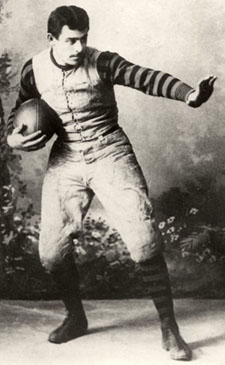
John Heisman at Pennsylvania
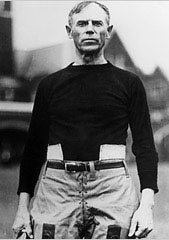
Coach John Heisman
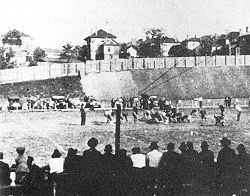
Georgia Tech vs Cumberland
Top of Page |
Reference: Rites of Autumn: The Story of College Football, Richard Whittingham
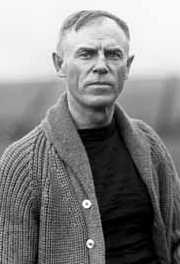
John Heisman
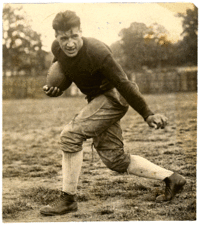
Joe Guyon
|
John Heisman served longest at Georgia Tech. Here is another story from his years in Atlanta.
Heisman's 1917 6-0 Ramblin' Wreck traveled to New Orleans to play Tulane on November 10. One of Tech's star players was Joe Guyon, who had an interesting history.
- Joe was a Chippewa Indian who played at Carlisle Indian School under legendary Coach "Pop" Warner in 1912-13. Guyon blocked for his famous teammate, Jim Thorpe.
- After three years at an academy in Chicago, Joe resumed his football career at Georgia Tech in 1917.
- He made an all-american team as a T that year but also ran the ball for Heisman.
In the years to come, Heisman told the story of Guyon's visit to the Crescent City.
- John told Joe that the oysters in New Orleans were a special treat.
- The afternoon of the game, the coach noticed his star sitting in a corner of the dressing room looking a bit under the weather.
- When Heisman asked him what was wrong, Guyon replied: "Raw oysters."
- "They didn't agree with you?"
- "Well, the first four or five dozen did. I think I got some bad ones after that."
Guyon's problem didn't hamper his team.
- The Yellow Jackets swamped the Green Wave 48-0 on their way to a 9-0 season.
- They outscored the opposition 491-17. They have been proclaimed national champions, retroactively, by Billingsley, Helms, Houlgate, the National Championship Foundation, and Parke Davis.
- Tech went undefeated for 33 straight games (including two ties) starting with the last two contests of 1914 to the second-to-last game of the 1918 season, a 32-0 loss at Pittsburgh.
Heisman's teams succeeded because he was a stern taskmaster.
- He conducted long practices.
- He imposed strict training rules including no hot-water baths or use of soap during the week because he considered them "debilitating."
- He loved to lecture the players in his booming voice, interspersing quotes from Shakespeare.
- A shift he invented in 1910 is named for him. A New York Sun article some time later described it thus:
... the entire team, except the center, dropped behind the scrimmage zone. The four backs took their post in Indian file at right angles to the rush line, forming the letter "T." ... One virtue of the balanced formation was that it could attack either flank with equal force. There were no strong- or weak-side plays as the shift swung left or right. At the shift signal the phalanx deployed with the startling suddenness of a Jeb Stuart cavalry raid, catching the defense off balance. No pause was required by the more lenient rules of that period, the absence of any momentary stop making it difficult for the defense to countershift in time.
|
|
|
Heisman shifted himself for the 1920 season to Penn, one of his alma maters.
- Three years later, he moved again, to Washington & Jefferson.
- Then it was off to Rice from 1924 to 1927, when he retired at age 60.
He served as president of the American Football Coaches Association twice.
- This is surprising since many of his contemporaries considered him "arrogant, "contentious," and "irascible."
- One reason he changed schools so often is that he quarrelled with his superiors, associates, and players.
- In retirement, he contributed articles on college football to Collier's magazine and the New York Evening Journal
John's memory is kept alive by the trophy that bears his name.
- Heisman was one of the founders and the first president of the Downtown Athletic Club of New York.
- The year he died, 1936, the club named its annual award, first presented the year before, after Heisman.
- So technically speaking, the first winner of "The Heisman Trophy" was not Jay Berwanger of Chicago, the 1935 recipient, but Larry Kelly of Yale.
|
Reference: Rites of Autumn: The Story of College Football, Richard Whittingham
Top of Page
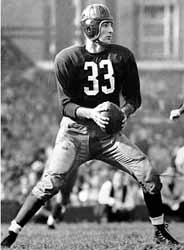
Sammy Baugh of the Redskins
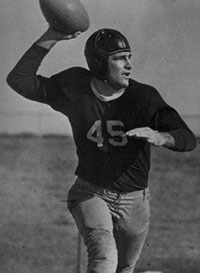
Sammy Baugh of TCU
|
The death of Sammy Baugh at age 94 on 12/17/08 brings to mind his great career and provides an opportunity to make a case for Baugh as the greatest football player ever. To jump right into that argument, consider that he set 13 NFL records in three different categories while playing his entire pro career with the Washington Redskins.
- Passer
- Most seasons leading league in passing – 6 (tied with Steve Young)
- Most seasons with lowest interception percentage – 5
- When he retired after the 1952 season, he also held these records.
- Single season completion percentage (70.3%)
- Most seasons leading league in yards gained (4)
- Most seasons leading league in completion percentage (7)
- Defensive back
- First player to intercept four passes in a game
- Punter
- Most consecutive seasons leading league in punting – 4
- Highest punting average in a career – 45.1 (currently surpassed by Shane Lechler)
- Highest punting average for a season – 51.4 in 1940 (also 3rd with 48.7 in 1941)
He is the only player to lead the league in passing, punting, and interceptions in the same season (1943). Now that is a record that will never be broken. [There are only two other players in NFL history who have led the league in three categories in the same season. Of course, all are from the limited substitution era.]
Sammy was the last surviver of the 17 original inductees in the Pro Football Hall of Fame in 1963. Also, his #33 is the only number ever officially retired by the Redskins.
Baugh is also a member of the College Football Hall of Fame for his great career at TCU from 1934-6. Starting varsity play for Coach "Dutch" Meyer just as the rules called for a slimmer football, Sammy threw 587 passes in three seasons for 39 TDs and was named All-American after the last two campaigns. In an era when 10 passes in a game was considered extravagant, he often threw 40 times.
Baugh led the Horned Frogs to two bowl victories.
- In the 1936 Sugar Bowl against LSU, Baugh punted 14 times for a 48 yard average, placing many kicks inside the 5 yard line. TCU won 3-2.
- In the inaugural Cotton Bowl in 1937, he directed the 16-6 victory over Marquette.
|
|
Some call Glenn Presnell the best NFL player who is not in the Pro Football Hall of Fame. His teams got the better of Red Grange not once, but twice.
- Glenn played three seasons at Nebraska at TB, making All-American in 1927. That year, he led the nation in total yards gained. He made all-Missouri Valley his junior year and all-Big 8 the next year after the Cornhuskers changed conferences.
- Presnell's first game at Nebraska in 1925 was a trip to Champaign to face Illinois and their superstar, Red Grange. The Cornhuskers had lost to the Illini the previous two seasons. Nebraska won 14-0. The game was the only one in his three college seasons that The Galloping Ghost did not score a TD. Red's longest run was 15 yards. The field, saturated by a driving rain before the game, contributed to Grange's difficulties. Presnell didn't play much.
- After college, Presnell played for and coached the Ironton Tanks, an Ohio semi-pro team that has been called the best team not to play in the NFL. Glenn taught science at the local high school while playing HB-QB in the single wing. At 5-10 190, he also played middle safety on D.
- The Tanks' shining moments came in the 1930 when they defeated both the New York Giants and the Chicago Bears, the second and third best teams in the NFL. The Giants game provided Presnell with his greatest football memory.
- With New York leading 12-6 and time running out, Presnell returned a punt to the enemy 27 before running out of bounds.
I asked the time keeper (who stood on the sidelines in those days) how much time was left, and he said three seconds. ... I knew that there was time left for only one play, a desperation pass. I dropped back and the line came running in on me.I broke away and began to run. The defense ... converged on me. I ... saw Gene Alford standing in the end zone by himself and threw it to him for the tying TD. I kicked the extra point and we won 13-12 when actually there wasn't any time left in the game.
- In the Bears game, Presnell scored twice, once on an 88y run, in the 26-13 victory. The star of the Chicago team? Red Grange.
- When the Tanks folded after that season because a small town team couldn't make it financially during the depression, Presnell joined the Portsmouth Spartans of the NFL. After three seasons, the franchise was sold to Detroit for $16,500.
- Glenn's most famous game with Portsmouth was the 1932 playoff game – the first in league history – against the Bears, whom the Spartans had tied twice during the season. Chicago won 9-0 to claim the title. This time, Grange got the better of Presnell.
- Presnell was named second-team all-Pro after the 1931 season and then made first team QB in 1933 when he led the league in scoring and placed second in passing.
- In 1934, Glenn kicked a 54-yard FG to beat Green Bay 3-0. That stood as the longest FG in league history for 19 years. Detroit was unscored on the first seven games of that season, a record that may stand forever. However, the Lions lost their last three contests, including the last two to the Bears, and did not win the Western Division.
- Presnell was the starting QB for most of the 1935 season when the Lions won the NFL championship.
- Glenn retired at age 31 after the 1936 season. He became an assistant coach at Kansas and Nebraska and then head coach at his alma mater for the 1942 season. He later coached Eastern Kentucky before becoming the school's first fulltime AD. He was inducted into the Nebraska Hall of Fame in 1973.
|
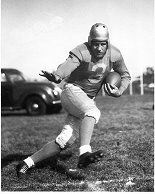
Glenn Presnell

Red Grange
|
|
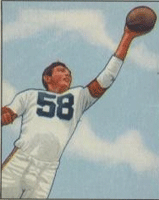
Mac Speedie

Paul Brown
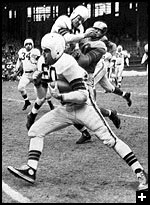
Otto Graham
|
Perhaps the numbers in Mac Speedie's football career aren't strong enough to put him in either the Pro Football Hall of Fame. However, if overcoming obstacles were factored in, he would surely be enshrined.
As a child in Utah, Mac wore braces on his legs for four years because of a bone deficiency disease. As a result, his left left was shorter and much thinner than his right throughout his life. When the braces were finally removed, then, in Mac's own words, "I had such a backlog of athletic amibition that I wanted to play football, basketball, and track all at one time."
He earned all-Salt Lake City as a HB in football and also played C in basketball. At the University of Utah, he was an all-Conference E each season from 1939-41. He also played basketball all three years (freshmen weren't eligible for varsity teams in that era) but excelled most in track. He set or tied conference records in the low and high hurdles.
After graduation, Mac entered the army in 1942. While serving at Fort Warren in Texas, he met with Detroit Lions' owner Fred Mandel, who offered him an NFL contract for $2,800. Speedie kept asking Mandel for a pen to sign but, the more Mandel talked, the more he got cold feet and ended up taking back the contract.
Mac played multiple positions, including T-formation QB, for the Fort Warren football team. One opponent was the El Toro Marines. At the end of the war, almost the entire team joined the new All-America Football Conference as the Chicago Rockets. The Rockets encouraged Speedie to join them in the new league. "By that time, I was a lieutenant and had a little more money and wasn't so anxious to sign." Instead, Speedie hitched his wagon to a team founded by another military base coach.
Fort Warren also played the Great Lakes Navy team coached by Paul Brown. Mac's play at DE caught Brown's eye and, in 1946, when he started an AAFC team in Cleveland, he signed Speedie. Playing E on O, Mac caught a pass for the first TD in AAFC history. QB Cliff Lewis threw it in a 44-0 victory over the Miami Seahawks. In the league championship game, Mac caught six passes for 71y in the Browns' 14-9 win over the New York Yankees.
With Otto Graham at QB the next year, Speedie started a string of three straight seasons leading the AAFC in pass receptions. In 1948, Mac took a screen pass from Graham and raced 99y for a TD against the Buffalo Bills. By the end of the 1949 season, the AAFC's last, Speedie held every league pass receiving record: most receptions in a season and a career and most yards in a season and a career.
In 1950, the Browns, San Francisco 49ers, and Baltimore Colts from the AAFC joined the NFL. Expected to be overmatched in the NFL, Cleveland proved they were no fluke by winning the championship. Mac caught a 13y TD in the title game against the Los Angeles Rams.
Speedie played for the Browns two more seasons, leading the NFL with 62 catches in 1952. The Browns played in their league's championship game all seven years he was with them.
In 1953, he joined his third pro league, the Western Interprovincial Football Union, forerunner of the Canadian Football League. He signed with Saskatchewan as part of the U.S.-Canadian player "war." He played three years north of the border before retiring. In 1960, he became part of still another pro league as E coach for the Houston Oilers of the AFL. In 1962, he moved to the Denver Broncos as OE coach. During the '64 season, he took over as head coach and remained into the '66 season, compiling a 6-19-1 record.
Not bad for a kid whom doctors feared would be crippled for life. If his three years in the AAFC had been played in the NFL, he would undoubtedly be enshrined in Canton.
|
|
Edward "Wahoo" McDaniel was one of the most colorful players to ever set foot on a gridiron. And he is even more well known in wrestling, a sport where he could express his individuality more openly.
- Edward was born in 1938 in Bernice LA. (Some sources say Bernice OK.) McDaniel later said of himself: "My mother was one-ninth Indian, and my father was a full-blooded Choctaw. That makes me more than half Indian." The family called him "Wahoo" after his father, "Big Wahoo."
- Wahoo played football and baseball in Midland TX where one of his baseball coaches was an oilman named George H. W. Bush. Despite sowing some wild oats as a teenager, he earned a scholarship from the legendary coach Bud Wilkinson at Oklahoma.
- Wilkinson tolerated more from Wahoo than he did from others. Injuries marred McDaniel's early years in Norman but, by his senior year, the 6' 230 lb LB was one of the top players on the team despite being caught drinking and skipping classes. He booted a punt 91y, the sixth longest in NCAA history.
- McDaniel was drafted by the Houston Oilers of the brand new American Football League in 1960. After playing all 14 games at LB that season, he was traded to the Denver Broncos for whom he toiled three years. Then he was involved in a nine-player trade with the New York Jets. According to the 1964 Jets yearbook, "The colorful McDaniel ... greatly strengthened the linebacking corps by adding experience in the middle."
- A crowd favorite during his two seasons in New York, Wahoo made 23 tackles in a game against the Broncos, his former team. The Miami Dolphins selected him in the 1966 AFL expansion draft to be one of their main attractions. However, during the 1968 season, he knocked out two police officers in a fracas. Traded to the San Diego Chargers, Wahoo decided to retire.
- He had started wrestling in the off seasons during his first year in the AFL. Using the name "Chief Wahoo," he became a coast-to-coast attraction by cultivating the feuds that are the heart and soul of pro wrestling. Using his signature move, the Tomahawk Chop (what else?), he won a number of titles.
- After several temporary retirements, Chief Wahoo left the ring for good in 1996. He died in 2002 at age 63 from diabetes and renal failure.
|
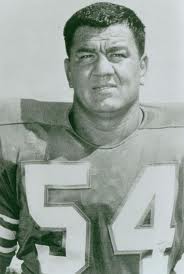
Wahoo McDaniel
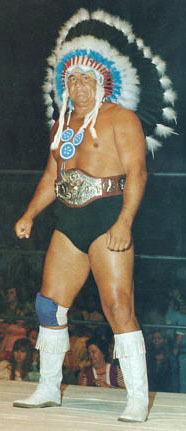
Chief Wahoo
|
|
Stephen Neal took a different route to becoming a starting O lineman with the New England Patriots. It's the rare player who achieves NFL success without playing a down of college football.
- A five-sport athlete at San Diego High School, Neal competed in wrestling, football, swimming, tennis and track and field. (One wrestling opponent was Rickey Williams, future Heisman Trophy winner.) As a 200-pound LB, he received only a few Division II football scholarship offers. So he chose to go to Cal-State Bakersfield where he became a two-time NCAA champion wrestler. In the finals his senior year, he defeated future UFC champ Brock Lesnar.
- Stephen earned the Dan Hodge Award, known as the Heisman Trophy of wrestling. He also won the U.S. Freestyle Championship, the Pan-American Games title and the World Championships He finished his career with an 88-match win streak.
- Despite not playing the sport in college, Neal maintained his love of football. "It was always a dream, and I'm not gonna let go of those," he says. It helped that he grew to nearly 300 pounds. His football career actually had its genesis in a wrestling disappointment.
- After being upset in the 2000 Olympic trials, Neal told 1996 Olympic silver medalist Matt Ghaffari about his football aspirations. Ghaffari put him in touch with agent Neil Cornrich. It so happens that Cornrich, an avid wrestling fan, had already identified Neal as someone who could make it in the NFL.
- Cornrich sent Stephen to a football trainer, Dave Kennedy, and got in touch with Patriots coach Bill Belichick. After working with Neal, Kennedy called NE's personnel chief, Scott Pioli (now the GM of the Kansas City Chiefs), to tell him that Neal deserved a look as a football player. Looking at Neal's wrestling tapes, Pioli invited him to the Patriots' training camp in 2001.
- After a brief fling on D, Neal moved to O before being cut at the end of camp. He returned to California for awhile before making the Eagles' practice squad. Then the Patriots signed him to their roster in December 2001, but he was not activated for any game the remainder of the season.
- Neal made his NFL debut in October 2002 and then started a week later. However, an injury sidelined him the rest of that season and all of 2003.
- In 2004, Neal played in all 16 games, starting the last 14 at RG. He continued as an important cog on the O-line that played a vital role in New England's Super Bowl championship.
- Stephen started every game in 2005 and then all of the 13 games he played in 2006, missing the other three contests due to injury. In 2007, he started all eight games he played and then the three post-season contests leading to the Super Bowl. He started 2008 on the injured list but took over his starting spot on October 20 and played the rest of the campaign.
|
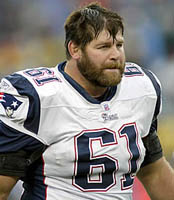
Stephen Neal of the Patriots
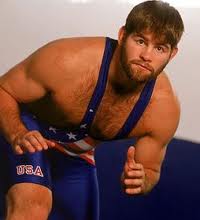
Stephen Neal, Wrestler
|
|
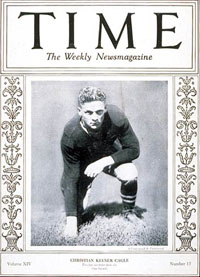
Chris Cagle with West Point
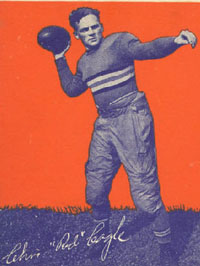
Cagle with New York Giants
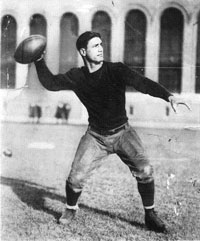
Benny Friedman
|
Christian Keener Cagle, later called the "Red Thunderbolt of West Point," was born in 1905 in Merryville LA in SW Louisiana (near DeRidder if that helps). He was one of eight children.
When he finished high school in 1922, his parents wanted him to attend Texas A&M. However, he instead chose Southwestern Louisiana Institute (SLI – today's Louisiana-Lafayette).
In his first college game, freshman Cagle returned two punts for touchdowns – one for 70 yards and one for 75 yards – in a 31-6 victory over the Tulane freshmen. A triple threat, Cagle rushed, passed and kicked for points. He was known for booming kicks and crowd-pleasing aerial attacks. Meandering runs of 30 yds or more were common. His passing ability in an era when that skill was utilized sparingly attracted the attention of the New York Sun, which wrote this.
In 1924, Southwestern, with a total of 125 forward passes, completed 67 successfully. That is a percentage of 53.5, and the students and coaches of the institute are quite sure that they made a world's record when they did it.
In his career for Coach Ray Mobley, he scored 42 TDs and two FGs to set a school record that lasted until 1989 when it broken by Brian Mitchell, who went on to NFL fame with the Washington Redskins. His last two seasons of football for SLI, Cagle averaged over 12 ypc. Admittedly the opposition was not the strongest, including the LSU and Tulane JV squads (his first year, then the varsities) and St. Stanislaus College in Bay St. Louis MS. Besides being the football captain, Cagle starred in basketball and track and field.
After he received a degree in arts and sciences, Cagle entered West Point in June 1926. Since athletes were not limited to four years of eligibility by the NCAA, he played four years for the Cadets. Undoubtedly helped by the fact that he was already 21 years old when he started at Army, Cagle made All-American each of his last three years (1927-8-9) and was named College Player of the Year for 1929.
To quote an article from his time at West Point, Cagle had "a flashing, elusive speed, a keen quick brain and the ability to literally fade from an opponent's grasp." He was "a hard, sure tackler, a superb broken field runner and a tremendous line plunger." He was known for playing with his chin strap flapping or even with no helmet.
Among his outstanding games were these.
- 1928: He galloped 74 and then 52 for TDs in an 18-6 victory over Yale.
- 1928: Army played Notre Dame before 80,000 at Yankee Stadium in what became the "Win One for the Gipper" game. With Rockne's D keying on him, Cagle didn't produce his usual numbers. However, when the Irish scored late in Q4 to take a 12-6 lead, he went into action. He ran the kickoff back 60y, then ran for 15 to the 20y line, then to the 5 and finally to the one-foot line. At that point, the timekeeper blew his whistle to end the game.
- 1929: He rambled 70 against Ohio Wesleyan and 65 against Yale.
In four years at West Point, Chris scored 169 points, averaged 6.4 yards per carry, and 26.4 on kickoff returns. Army compiled a 30-8-2 record for Biff Jones (who coached LSU from 1932-4).
Cagle didn't graduate from West Point. He was forced to resign because, after two years up North, he had secretly wed a girl he had met at SLI.
In 1930, he coached Mississippi A&M (now Mississippi State) to a 2-7 record (one of the victories being against LSU 8-6) before playing pro football for parts of five years.
- After A&M's last game on November 27 (a loss to archrival Ole Miss), Cagle joined the New York Giants for their game against the Brooklyn Dodgers on November 30. He then played for New York through the 1932 season. Expected to form a dynamte run-pass combination with QB Benny Friedman, Chris didn't produce near the numbers he did in college, partly because of injuries, one of which occurred when he tried to tackle the famous Bronco Nagurski.
- In 1933, he and a former Giants player became co-owners of the NFL's Brooklyn Dodgers franchise. Cagle played for that team in 1933 and 1934.
Cagle died tragically in 1942 after falling headlong down the subway stairs on an icy day in New York City. While recuperating from a fractured skull, he succumbed to pneumonia. He is honored by a monument in the SW corner of Louisiana-Lafayette's field.
|
|
Brad Van Pelt
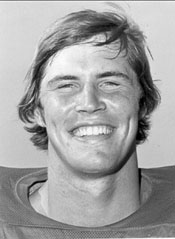
Brad Van Pelt
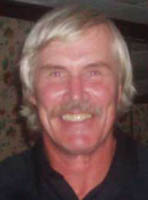
Van Pelt Late in Life
|
Former NFL linebacker Brad Van Pelt died in February 2009 at age 57 of a heart attack.
Born in Owosso MI, Brad made all-State as a QB at Owosso High as well as all-league in basketball and baseball. He also played D on the gridiron. Both the Detroit Tigers and the California Angels tried to sign Van Pelt out of high school but he declined.
One high school sports reporter had this recollection.
He was like a man among boys. He was about 6-5, 220. One night, his coach from Owosso called in and said he got 32 rebounds in a game. I didn't put that in the paper. I didn't believe that. So, the next game I went out when they played Davison and I just counted his rebounds and he got 42. He was just so dominant.
Van Pelt lettered seven times in football, basketball, and baseball at Michigan State from 1970-1973.
- On the gridiron, he was an All-American DB in 1971 and 1972. In the latter year, he won the Maxwell Award as the nation's best player, the first time the trophy had been given to a DB. He also garnered Chevrolet Defensive Player of the Year and Columbus Touchdown Club Defensive Player of the Year.
- Brad played three seasons on the hardwood as – what else? – a power F.
- Van Pelt was a RHP whom the Cardinals tried to sign away from the NFL.
- Because he signed early with the Giants, Brad had to forego his final seasons of basketball and baseball. He later confessed his regret that he did not earn nine Spartan letters. (Freshmen were ineligible for varsity sports in that era.)
Station WILX in Michigan made this comment after Brad's death.
If Brad Van Pelt wasn't Michigan State's all time greatest athlete, then who was? Will we ever see a seven letter athlete again? A guy who starred in three sports? It just doesn't happen. Will MSU ever have the college football player of the year again?
The New York Giants chose him in the second round of the 1973 draft.
- During his 11 eleven years with the Giants, he made the Pro Bowl five times.
- He was also named the team's Player of the Decade for the 1970s.
|
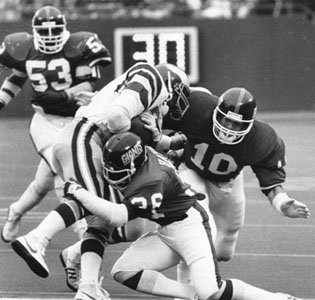
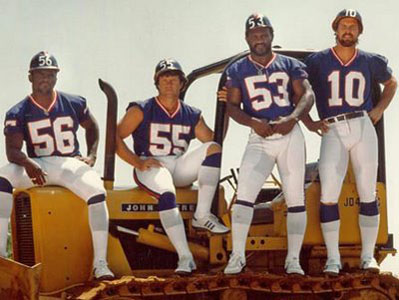
Van Pelt (#10) in action and The Crunch Bunch of the Giants |
| |
Brad returned to MSU in 1998 to complete his degree. He was then elected to the Spartan Hall of Fame in 2000 and the College Football Hall of Fame in 2001.
|
|
Jake Delhomme, QB of the Carolina Panthers from 2003 through 2009, once had a fantastic all-around game at Father Teurlings High in Lafayette LA.
- Jake passed for more than 400 yd.
- He intercepted two passes.
- He saved the victory by blocking a late FG attempt.
Jake made All-State as a senior on defense, not as a QB, despite throwing for over 3,300y and 32 TDs.
Delhomme went to his hometown school, Louisiana-Lafayette (USL at the time) when LSU and other major schools ignored him.
- The only true freshman QB to start for a Division I-A school in 1993, he led the Cajuns to three consecutive winning seasons and a pair of Big West Conference championships in 1993 and 1994.
- As a senior, he engineered the biggest win in school history over nationally-ranked Texas A&M 29-22.
- Finishing his career as the school's all-time leader in passing yards and TDs, Jake was inducted into the ULL Hall of Fame in 2006.
Jake was not one of the 11 QBs chosen in the 1997 NFL draft.
- He wasn't even invited to the NFL Scouting Combine.
- He had to trick his way into a tryout for the Saints. Since the call was only for players within a 30-mile radius of N.O., he gave his aunt's address in Metairie.
- His ruse paid off because, a month later, the Saints signed him as a free agent.
- He was waived before the season started but resigned to the practice squad that November.
Delhomme played two springs in NFL Europe (1998-9).
- His team won World Bowl VII.
- However, in five seasons with the Saints, he appeared in only six games, starting two in 1999 when the starter was hurt. One of those starts was a Christmas Eve upset of the Dallas Cowboys.
- Jake's performance in the nationally-televised contest caught the attention of many across the NFL, including Carolina coach John Fox.
- He also impressed opponents one game in 2002. The Saints led Tampa Bay by 3 late in the game when starting QB Aaron Brooks got hurt. Delhomme came off the bench cold and on the first play completed a 10y slant pass to Joe Horn on third-and-8. This enabled the Saints to run out the clock.
- Jake's clutch play impressed Bucs LB Derrick Brooks, who sees it as the start of Delhomme's career as Tampa Bay nemesis.
The last four games of the 2002 season sealed Jake's fate in N.O. and started a chain of events that eventually cost Haslett his job.
- Jake came in against the Ravens in Baltimore to complete 7 of 8 after Brooks, with a shoulder injury that would require surgery after the season (despite the Saints' protestations to the contrary), had to leave the game with only 9 completions in 25 attempts. N.O. won 37-25 for a 9-4 record.
- All the Saints had to do was win one of the remaining three games to clinch a playoff berth.
- It was not to be. Haslett insisted on starting Brooks who was obviously not close to 100%.
- The last game was against the Panthers in the Superdome. Despite losing the previous two, New Orleans could still make the playoffs with a win.
- Carolina won 10-6 as Haslett ignored the loud boos every time Brooks threw an incompletion or interception and the chants for Jake.
- Carolina scouts, checking Delhomme as a possible free agent for '03, noticed something that many Saints fans had observed all season. When the Saints had the ball, Jake would stand close to the play-caller. When the O left the field, Brooks would sit on the bench by himself while Delhomme would look at the still pictures from the last series with the O coordinator. Furthermore, it was Jake, not Aaron, who walked in front of the bench, interacting with the players.
- One the Panthers scouts says he and his cohorts concluded, "This guy is respected. He's got leadership qualities."
Carolina signed Delhomme to a multi-year contract before the 2003 season.
- He started 15 of 16 games, leading the Panthers to a 10-5 regular season record and a berth in the Super Bowl.
- They lost to the Patriots 32-29 in one of the most thrilling Super Bowls ever. Jake went 16-33 for 323y, 3 TDs, and 0 INT. He completed an unforgettable 85y TD pass to Muhsen Muhammad.
- Jake threw for over 600 more yards the following season than he had in '03 but injury-riddled Carolina finished only 7-9.
- He started all 16 games again in 2005 for an 11-5 record.
- Injuries kept him out of three games in 2006 but he wasn't as lucky in 2007 when he suffered a season-ending shoulder injury in Game Three.
- After Tommy John surgery, he started every game in 2008 for a 12-4 record. That brought his career record as a starter to 50-31.
- Not bad for a guy Jim Haslett wouldn't play even when his starting QB was obviously hurt.
|
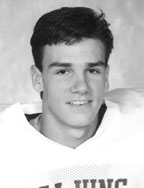 Jake Delhomme as a Ragin' Cajun
Jake Delhomme as a Ragin' Cajun
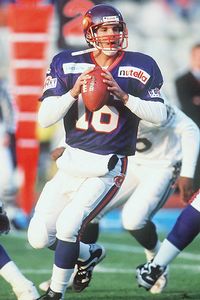
Delhomme in NFL Europe
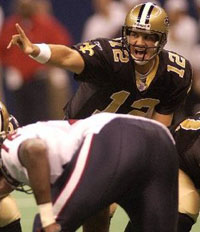
Delhomme as a Saint
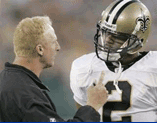
Jim Haslett and Aaron Brooks
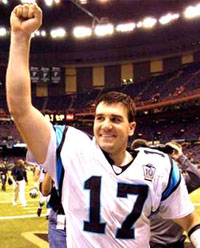
Delhomme after leading the Panthers to a victory over his former team in the Superdome |
|
|
CONTENTS
John Heisman - I
John Heisman - II
Sammy Baugh
Glenn Presnell
Mac Speedie
Wahoo McDaniel
Stephen Neal
Chris Cagle
Brad Van Pelt
Jake Delhomme
Football Profiles - II
Football Profiles - III
Football Profiles - IV
Football Profiles - V
Football Profiles - VI
Football Magazine
Golden Rankings Home
Top of Page |

